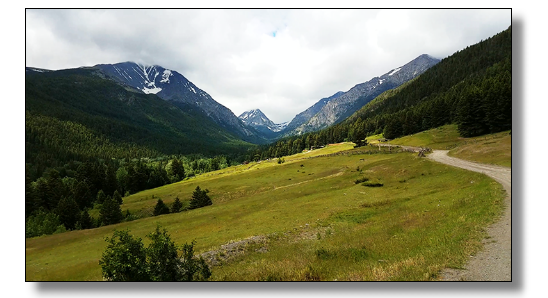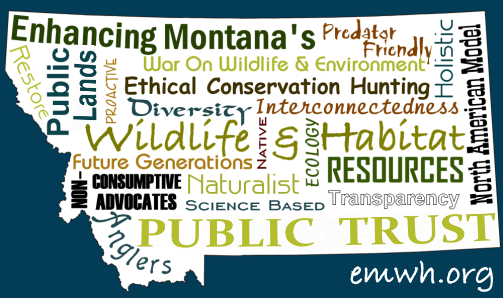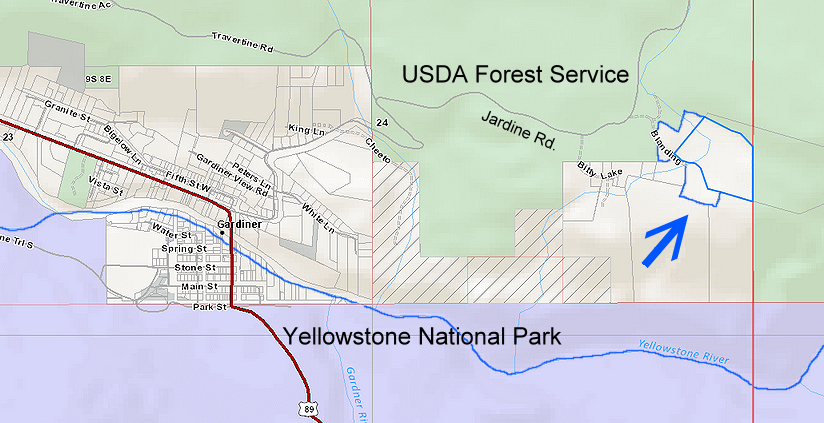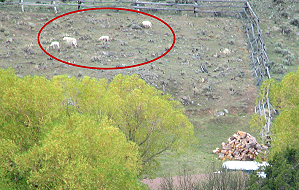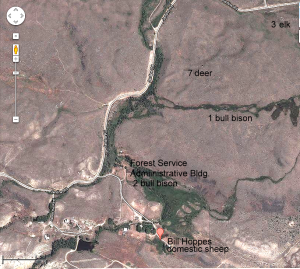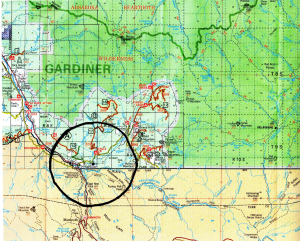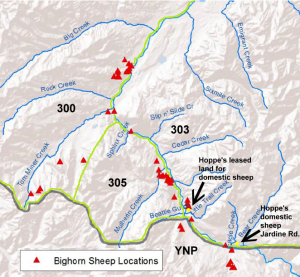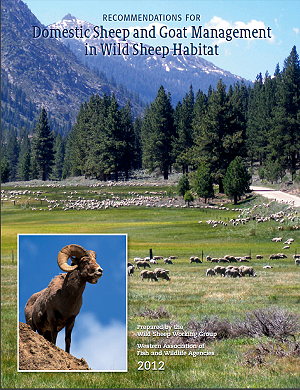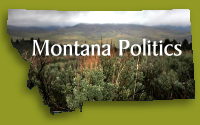Bill Hoppes
Domestic Sheep Threat
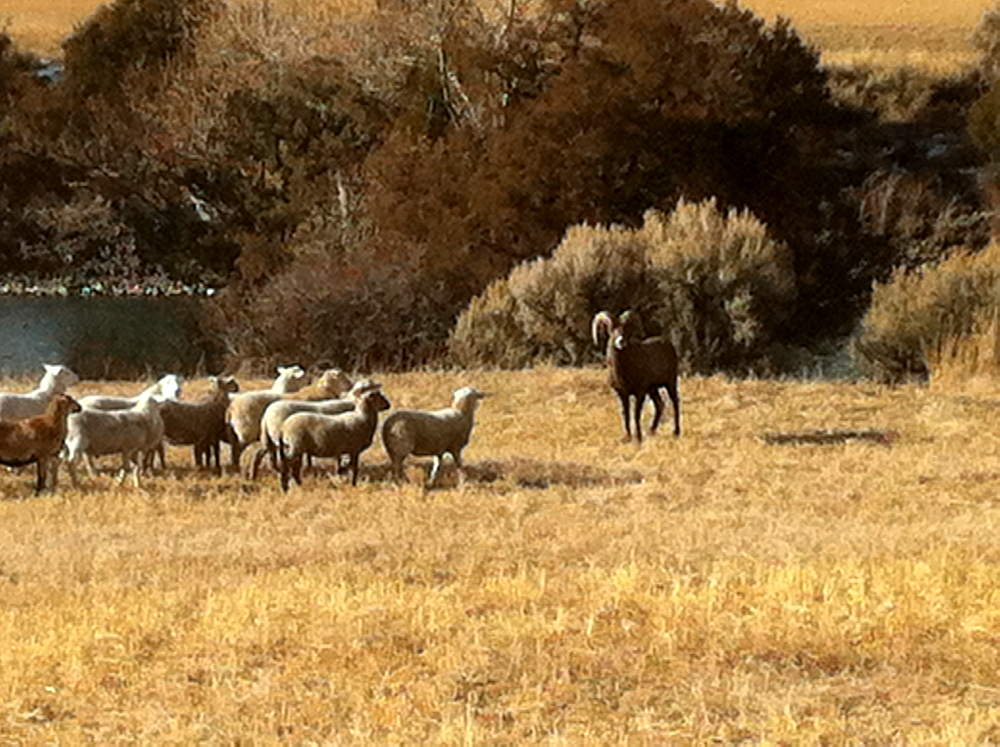
Bill Hoppes domestic sheep near wild Bighorn
Sheep, just north of the Yellowstone National Park,
Gardiner, MT, near the Yellowstone River. Domestic sheep and goats are
natural
carriers of pneumonia which infects, killing most wild Bighorn Sheep
and Mountain Goats,
as well as being natural carriers of Malignant
catarrhal fever (MCF), which is lethal to bison and deer.
| If a person
illegally kills wildlife outside of a designated hunting season
there are laws to prosecute that person as a poacher.
If a person kills game wildlife and leaves that game meat to rot, that person can be prosecuted for waste of game. If a person sets fire to our public lands, destroying them, that person can be prosecuted as an arsonist. So what do you call it when a person uses domestic livestock that naturally carry diseases that are not lethal to them, kind of like a Thyphoid Mary, to intentionally, lethally threaten your public wildlife? Bill Hoppe is one such individual from Gardiner, Montana. His intentional irresponsibility has lethally endangered our native wildlife. |
|
Photo
taken by Deby Dixon, a Gardiner wildlife photographer, as the young
Bighorn was dying of pneumonia, literally drowning in its own fluids
produced by the pneumonia. Timeline Beginning of April 2013 Bill Hoppe brought a small hobby herd of about 30 domestic sheep into the Gardiner, Montana area, just north of Yellowstone National Park. He had not raised domestic sheep before and there were no other domestic sheep herds in this area. This is not his livelihood. "Hoppe told the Chronicle in April that he purchased his first 30 sheep that month as a gift to his grandchildren. Prior to that, he'd raised only cattle." Hoppe is also a very vocal opponet of wolves and bison, repeatedly submits written and vocal public comments, as well as interviews against Yellowstone National Park and Montana Fish, Wildlife & Parks. I have been to numerous meetings where these long tirade speeches occur. Bill Hoppe is also an outfitter that profits from the Public Wildlife. The domestic sheep were placed on a parcel north of Gardiner, leased from a family member, bording the Yellowstone River on the east side. April 26, 2013 - Sheep killed by wolves near Gardiner After the news of the sheep killing I called USDA Wildlife Services state director John Steuber and spoke with him about the event. They investigated and determined that it was 2 wolf tracks at the site. Hoppe requested wolf kill permits. APHIS said there was no need, that he was moving the remaining sheep to another location, they dont just go after any wolf. Hoppe then moved the remaining sheep to his home property on Jardine Rd. Hoppe then contacted FWP to demand a kill permit, which he received, though there had not been a predation before, the sheep had been moved, he had not met the requirements in the FWP kill permit prevention methods first. The dead animals were not moved for almost 2 weeks, which caused a controversy of Hoppe baiting wolves with dead carcasses. May 6, 2013 - Hoppe shoots a random collared wolf, originating from Yellowstone National Park, that may not have been part of the previous sheep killing. The black wolf was wearing a VHF radio collar that identified it as “831F,” a member of the park’s Canyon Pack, which was involved in a study. He took pictures posing with it, which created another controversy. May 8, 2013 - Gardiner man kills Yellowstone Park wolf Yellowstone wolf-killer is baiting animals with dead sheep As a result of the bad publicity that followed, Bill Hoppe claimed to the Bozeman Chronicle that he had received hate mail and 2 death threats and would relinquish his second wolf kill permit. May 14, 2013 - Landowner Tells FWP He Will Forfeit Permission to Kill Second Wolf May 15, 2013 - Gardiner man to turn in wolf permit Oct. 24, 2013 - Wildlife advocates react to return of controversial sheep Hoppe returned the domestic sheep back to the leased parcel of land along the Yellowstone River, north of Gardiner, causing numerous wildlife advocates to contact FWP about the threat. This was especially dangerous to Bighorns who were about to enter the breeding season and would be attracted to the domestic sheep. Dec. 3, 2013 - Bighorn sheep mingle with Gardiner domestic sheep On Thanksgiving Day, Kevin Hurley, conservation director for the Wild Sheep Foundation, was driving to Gardiner from Livingston. He spotted Hoppes domestic herd of sheep, saw a Bighorn ram jump into the pasture with the domestic sheep. Just across the river tourist and wildlife photographers were photographing a Bighorn Sheep herd of between 60-70 Bighorns. Dec. 15, 2014 - Pneumonia Detected in Gardiner Area Bighorn Sheep What all articles reporting the beginning of this all age die off failed to report, was the existence, threat and documented commingling of Bill Hoppes domestic sheep and that of the Gardiner Bighorn Sheep. Also, that in all documented cases of domestic sheep and Bighorn commingling or in test cases of exposure, the result is always the same - the Bighorn Sheep or Mountain Goats always die. And what all the articles have consistently shown, are live Bighorn Sheep with the articles, rather than images of the dead. This is sending mixed messages to the brain and imagery is the more dominant to our brain. Dec. 2014, I spoke with FWP wildlife veterinarian Jennifer Ramsey as to the tests of the Bighorn Sheep, had they checked with Bill Hoppe to test his domestic herd for strain comparison. She stated they had asked, but he declined. Jan. 2015 - I spoke with Howard Burt, FWP's Region 3 chief Wildlife Biologist about the number of the die off at about 30 now, which he confirmed. On Jan. 17th I passed the information on to Laura Lunquist at an elk meeting to confirm with Burt. Jan. 19, 2015 - More Gardiner-area bighorn sheep die Mar.
19, 2015 - Bighorn
die-off could close district to hunting The die-off has prompted Montana's Fish and Wildlife Commission to meet via a telephone conference call at 8:30 a.m. Monday to consider an emergency closure of bighorn sheep hunting in the district, Hunting District 305." Pneumonia
kills dozens of bighorn sheep north of Yellowstone Park 'The disease event is not over yet,' said Karen Loveless, a Montana Fish, Wildlife & Parks wildlife biologist in Livingston." Mar. 24, 2015
- Sheep die-off prompts hunting district closure The emergency action came in response to a pneumonia
die-off that began late last year in bighorn sheep hunting district
305, near Gardiner. So far at least 34 sheep from the native herd
have died. March 26, 2015 - I received my call back from FWP wildlife veterinarian Jennifer Ramsey as to the results of the Bighorn Sheep tests from the fall of 2014. The tests show positive for pneumonia: Mycoplasma ovipneumoniae, Mannheimia haemolytica and some Bibersteinia trehalosi (not a primary, it is secondary but over takes M. haemolytica, B. trehalosi affects domestic sheep and cattle as well) - all fatal to bighorns. Here is a paper explaining Mannheimia haemolytica and Bibersteinia trehalosi relationship and that domestic cattle can carry this and lethally transmit to Bighorn Sheep. A Bighorn Sheep Die-off in Southern Colorado Involving a Pasteurellaceae Strain that May Have Originated from Syntopic Cattle |
Bill Hoppe has ranched small amounts of domestic cattle for years. He owns property on Jardine Road in Gardiner, Montana, north of Yellowstone National Park, east of the Yellowstone River.
While people can speculate as to Hoppes motives for bringing the domestic sheep into the wildlife corridor, threatening bison and bighorn sheep with diseases and the conflict threat with the YNP wolves, there is no documented statement from Bill Hoppe, only comments from various people in discussion with him, not going on record, as to his motives. Bighorn Sheep Pneumonia Disease Page
One thing is for certain, Hoppe has been notified by various wildlife agencies like Yellowstone National Park, Montana Fish, Wildlife & Parks, APHIS, the Wild Sheep Foundation, and others that those domestic sheep pose a disease threat to the wildlife north of the Yellowstone National Park. Hoppe refuses to remove the herd from the area, refuses to accept double fencing offers. This is an intentional offense to your public wildlife, just as if he struck a match and lit a forest fire on public lands. Hoppe has placed his domestic sheep at two locations north of Yellowstone National Park. One is his home location up on Jardine Road and the second is a piece of property owned by a relative which borders the Yellowstone River north of Gardiner, exposing even more Bighorn and bison populations to disease.
Below is a map showing Hoppes Jardine sheep location and the wildlife I spotted on that May 2013 documentation hike. Click for larger view. Malignant catarrhal fever threat to bison , which domestic sheep are natural carriers of, lethally affects bison and deer. But with bison and deer, they dont have to be nose to nose. MCF is transmitted as an aerosol up to a 3.1 mile radius, with a 7 day incubation. MCF will kill an infected deer or bison within 2-3 days on average.
As a result of the Gardiner Bighorn
Sheep die offs, Bighorn Sheep Hunt District 305 was closed. Below
is a map showing a big overview of the Bighorn Sheep populations
from FWP population survey data, the hunt district boundaries, Hoppes
home location and the secondary leased parcel where his sheep have
been located. Click to enlarge map.
Wild Sheep Working Group Executive Summary
Click on cover image for a PDF copy of Recommendation for Domestic Sheep and Goat Management in Wild Sheep Habitat
|
Your Advertisement Here |
Site designed and maintained by Kathryn QannaYahu
